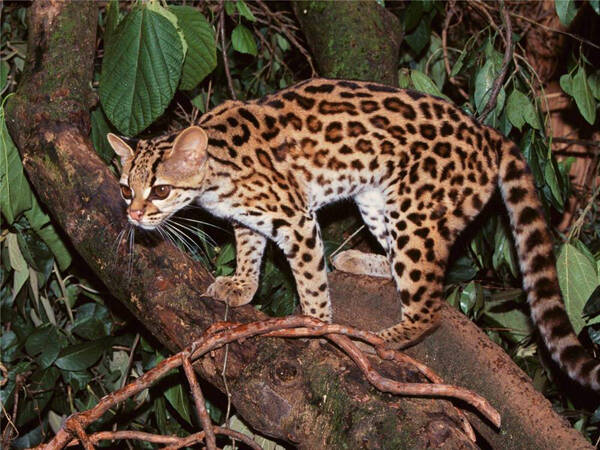Leopardus wiedii
IUCN
LCBasic Information
Scientific classification
- name:Leopardus wiedii
- Scientific Name:Leopardus wiedii,Margay
- Outline:Carnivora
- Family:Felidae Ocelothrix
Vital signs
- length:43-80cm
- Weight:3-9kg
- lifetime:20-24years
Feature
The head is shorter, the tail and limbs are longer, and the spots on the tail are also different.
Distribution and Habitat
Distributed in Argentina, Belize, Bolivia (Plurinational State), Brazil, Colombia, Costa Rica, Ecuador, El Salvador, French Guiana, Guatemala, Guyana, Honduras, Mexico, Nicaragua, Panama, Paraguay, Peru, Suriname, Uruguay, Venezuela, Bolivarian Republic of.
Margays prefer to live deep in the rainforest and originally lived in Central and South America. Margays are mainly arboreal, living only in forest areas, and sometimes they can be seen occasionally in the tall trees of coffee and cocoa plantations. They used to live in Texas, USA, but now their homeland is limited to Mexico in the north, extending southward to Uruguay through Central America.
Appearance
The Margay is a beautifully patterned cat with a head-body length of 43-80 cm, a tail length of 30-51 cm, and a weight of 3-9 kg. They resemble larger Margays, but with a shorter head, longer tail and limbs, and different spots on the tail. They can rotate their heels 180°, and can also hold branches firmly with their front and hind limbs, and jump long distances. They can hang on trees with one limb. They can jump up to 6 meters in height and 8 meters in long jump.
The fur color ranges from yellow-brown to gray-brown, marked with black rows and open wreaths. There are black lines on the head, neck and throat, and the back of the ears are black with white spots in the middle. The lower body is white on the chest and abdomen, and the tail has quite dense black rings. The fur is relatively thick, soft, and tilts back unusually behind the neck. Males and females are similar in size and appearance.
Details
The long-tailed tiger cat (scientific name: Leopardus wiedii) is also known as Margay in foreign languages. It is a large tiger cat with 11 subspecies.

The long-tailed tiger cat lives alone and is active at night. They are good tree climbers and can live their entire lives in trees, traversing them to hunt birds and monkeys. They are one of two cat species that have flexible heels to climb trees, the other being the clouded leopard.
Margays mainly eat small mammals, birds, eggs, lizards and tree frogs. They also eat grass and other plants to help digestion. They also hunt squirrels, which confirms that they can feed entirely in trees. Because Margays are so rare, most studies on their diet are based on analysis of their stomach residues and feces.
Margays can breed year-round, with a gestation period of about 84 days, and give birth to 1-2 pups per litter. Female cats breed once every 2 years. The lifespan of Margays in captivity is 24 years. Margays prefer to live alone in the wild, but in captivity, female and male margays are happy to stay together even when they are not in the courtship period. The gestation period is about 76-85 days, but usually only one baby is born. The baby is usually weaned at about 2 months and takes 8-10 months to grow up.
Margays have become the target of crazy hunting by humans because of their beautiful fur. In the late 1980s, people finally restricted the fur trade of margays, but poaching still occurred in an endless stream. In addition to the slaughter caused by greed, there are two other reasons that make their population increasingly worrying. One is the uncontrolled deforestation. Margays are shy and timid animals. When the forest is broken due to deforestation, their timid character prevents them from crossing these dangerous human broken belts to find happiness during the courtship season, so their offspring are getting fewer and fewer. In addition, their beautiful fur makes them the darling of the pet market like ocelots. Therefore, they are on the verge of extinction.
Listed in the 2015 Red List of Endangered Species of the World Conservation Union (IUCN) ver 3.1 - Near Threatened (NT).
Listed in Appendix I, Appendix II and Appendix III of the 2019 edition of the Convention on International Trade in Endangered Species of Wild Fauna and Flora (CITES).
Protect wild animals and eliminate game.
Maintaining ecological balance is everyone's responsibility!








